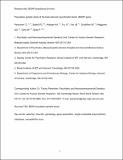| dc.contributor.author | Petryshen, Tracey Lynn | |
| dc.contributor.author | Sabeti, Pardis Christine | |
| dc.contributor.author | Aldinger, Kimberly A. | |
| dc.contributor.author | Fry, Ben | |
| dc.contributor.author | Fan, Jinbo B. | |
| dc.contributor.author | Schaffner, Stephen | |
| dc.contributor.author | Waggoner, Skye G. | |
| dc.contributor.author | Tahl, Anthony R. | |
| dc.contributor.author | Sklar, Pamela | |
| dc.date.accessioned | 2011-11-14T19:05:26Z | |
| dc.date.issued | 2010 | |
| dc.identifier.citation | Petryshen, Tracey L., Pardis C. Sabeti, Kimberly A. Aldinger, Ben Fry, Jinbo B. Fan, Stephen F. Schaffner, Skye G. Waggoner, Anthony R. Tahl and Pamela Sklar. 2010. Population genetic study of the brain-derived neurotrophic factor (BDNF) gene. Molecular Psychiatry 15(8): 810-815. | en_US |
| dc.identifier.issn | 1359-4184 | en_US |
| dc.identifier.issn | 1476-5578 | en_US |
| dc.identifier.uri | http://nrs.harvard.edu/urn-3:HUL.InstRepos:5345308 | |
| dc.description.abstract | Genetic variants in the brain-derived neurotrophic factor (BDNF) gene, predominantly the functional Val66Met polymorphism, have been associated with risk of bipolar disorder and other psychiatric disorders. However, not all studies support these findings, and overall the evidence for the association of BDNF with disease risk is weak. As differences in population genetic structure between patient samples could cause discrepant or spurious association results, we investigated this possibility by carrying out population genetic analyses of the BDNF genomic region. Substantial variation was detected in BDNF coding region single-nucleotide polymorphism (SNP) allele and haplotype frequencies between 58 global populations, with the derived Met allele of Val66Met ranging in frequency from 0 to 72% across populations. FST analyses to assess diversity in the HapMap populations determined that the Val66Met FST value was at the 99.8th percentile among all SNPs in the genome. As the BDNF population genetic differences may be due to local selection, we performed the long-range haplotype test for selection using 68 SNPs spanning the BDNF genomic region in 12 European-derived pedigrees. Evidence for positive selection was found for a high-frequency Val-carrying haplotype, with a relative extended haplotype homozygosity value above the 99th percentile compared with HapMap data \((P=4.6 \times 10^{−4})\). In conclusion, we observed considerable BDNF allele and haplotype diversity among global populations and evidence for positive selection at the BDNF locus. These phenomena can have a profound impact on the detection of disease susceptibility genes and must be considered in gene association studies of BDNF. | en_US |
| dc.description.sponsorship | Organismic and Evolutionary Biology | en_US |
| dc.description.sponsorship | Other Research Unit | en_US |
| dc.language.iso | en_US | en_US |
| dc.publisher | Nature Publishing Group | en_US |
| dc.relation.isversionof | doi:10.1038/mp.2009.24 | en_US |
| dc.relation.hasversion | http://www.ncbi.nlm.nih.gov/pmc/articles/PMC2888876/ | en_US |
| dash.license | OAP | |
| dc.subject | selection | en_US |
| dc.subject | diversity | en_US |
| dc.subject | genealogy | en_US |
| dc.subject | gene association | en_US |
| dc.subject | single-nucleotide polymorphism | en_US |
| dc.subject | haplotype | en_US |
| dc.subject | susceptibility locus | en_US |
| dc.title | Population Genetic Study of the Brain-Derived Neurotrophic Factor (BDNF) Gene | en_US |
| dc.type | Journal Article | en_US |
| dc.description.version | Accepted Manuscript | en_US |
| dc.relation.journal | Molecular Psychiatry | en_US |
| dash.depositing.author | Sabeti, Pardis Christine | |
| dc.date.available | 2011-11-14T19:05:26Z | |
| dash.affiliation.other | Harvard Medical School, Department of Psychiatry | en_US |
| dash.affiliation.other | Stanley Center for Psychiatric Research, Broad Institute of MIT and Harvard | en_US |
| dash.affiliation.other | Broad Institute of MIT and Harvard | en_US |
| dash.affiliation.other | Harvard School of Public Health, Department of Immunology and Infectious Diseases | en_US |
| dc.identifier.doi | 10.1038/mp.2009.24 | * |
| dash.contributor.affiliated | Petryshen, Tracey L. | |
| dash.contributor.affiliated | Schaffner, Stephen | |
| dash.contributor.affiliated | Sabeti, Pardis | |


